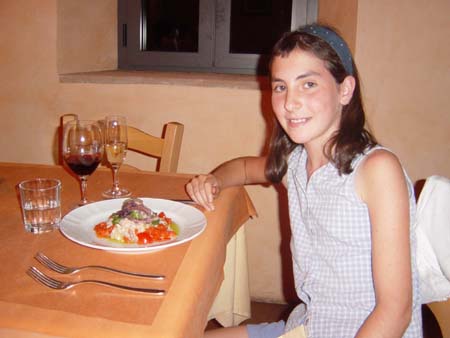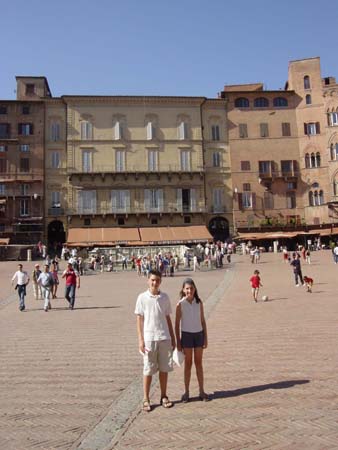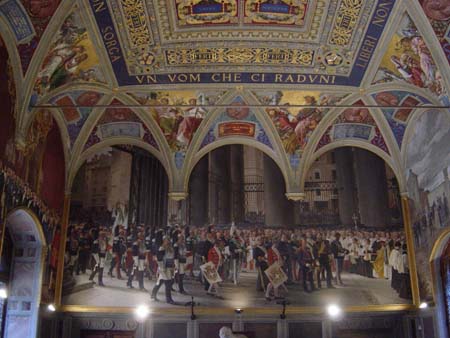SEPTEMBER 19, 20 PICTURE ALBUM
Friday September 19 and Saturday September 20
Steve: Knowing that we have a full and busy schedule
coming up early next week, we decided to use much of these two days to catch
up on errands, planning and schoolwork activities. We have found that we all
need breaks like these, and we've clearly started to feel like we're "living"
here in Tuscany instead of simply visiting for a short burst.
Yesterday, we set out in the afternoon for another hike through the countryside,
followed by a fantastic dinner. We parked in Gaiole-in-Chianti and simply
started walking up a gravel road that leads up from the village. Soon we had
great views of the surrounding area, and we enjoyed watching another sunset
over the hills. For dinner, we treated ourselves to a restaurant called Badia
a Coltibuono. We had heard many good things about this restaurant, and it
is also has its own cooking school. The food was great, and we tried some
new dishes - Katie had pasta with octopus, David enjoyed a tripe salad, and
I had soup with pigeon and chick peas. The restaurant is high on a hill in
the woods, and is next to a beautiful old abbey - a really neat setting.
Today, after schoolwork, we went into Siena to take care of errands. We went
to a travel agency to arrange our air travel for Spain and Morocco, David
and I got haircuts (extremely fun, especially since the women cutting our
hair spoke no English!), and we did grocery shopping. We also visited some
of Siena's churches and museums, including the Palazzo Publicco (in the Piazza
del Campo) and the Duomo. The Sienese are famous for their frescoes, and we
enjoyed seeing the frescoes that cover every inch of wall and ceiling in the
Palazzo Publicco.
This afternoon, we tried very hard to get tickets to the football match that was happening in Siena's stadium. This was apparently a very big game, and has been sold out for weeks. Our thinking was that we'd buy tickets from someone selling on the street, but unfortunately this is not how things work here - everyone uses their tickets! Also, the stadium here only seats 2,000 people. We asked several people and hung out at the gates, but there were no tickets to be had (even at a premium). We still very much intend on witnessing European football in person, but it may not happen here in Italy… (too bad, because it looked like a very exciting environment - the Sienese fans were singing and getting crazy a full 2 hours before game time).
Tomorrow we have one more relaxing day planned. Then we'll be heading to Florence on Monday and Wednesday, sandwiched around a trip to Montalcino on Tuesday with Roberta. The weather continues to be perfect every day - we hope it holds up for next week.
Distance Walked: Friday - 4.23 miles, Saturday - 3.85 miles
Katie's Komments - The topic for today is…frescos
No matter what cathedral or chapel we go to in Europe there are hundreds sometimes even thousands of wall frescos. I have found the process and types of fresco painting to be very interesting, especially the stories of Michaelangelo painting his famous Sistine Chapel. We have learned about two major types of fresco painting, fresh and dry. We have also studied a little bit on the process of painting these very difficult and complicated frescos. The following paragraphs briefly discuss the processes of these types of frescos step by step.
Buon fresco also known as "True (fresh)"
This style of fresco painting is more difficult than the dry fresco technique but also lasts longer. The steps an artist used to paint a fresh fresco were…
1. Apply pigments on top of several layers of plaster
2. Before the last layer of plaster apply a sketch or cartoon of the painting
3. Reinforce your figures by applying black watercolor paint
4. Apply plaster to your painting in small sections and add color while it
is wet
5. As the plaster dries, the lime in the plaster will react chemically with
the carbon dioxide in the air to form calcium carbonate. This compound forms
a film over the colors which bind them to the plaster.
6. Warning: The painting must be done quickly and confined to all essentials.
You must know precisely how much watercolor the plaster will absorb to successfully
complete your fresco. Too much paint causes the surface to become "rotten."
Cutting away the defective portion and repainting it is then necessary.
7. If this procedure is done correctly the colors of your fresco should come
out very clear and bold
Some examples of famous fresh frescos are Michaelangelo's Sistine Chapel, Raphael's School of Athens, and Vasari's Last Judgment in the Duomo (Florence).
Fresco Secco also known as "Dry fresco"
This style of fresco painting is much easier than the fresh fresco technique but also doesn't last as long. The steps an artist used to paint a dry fresco were…
1. Rub dry plaster with pumice stone to remove the crust
2. Wash this with a very thin mixture of water and lime.
3. Apply your colors onto the plaster
4. Note: the effect of this technique does not match the clear and durable
effect of the fresh frescos. Your dry fresco will also not last as long as
the fresh ones will.
All in all, the various techniques of fresco painting dating back to the Ancient Egyptians served and still serve many purposes today. From the early churches covered in these colorful designs and figures to the decoration of modern buildings today the stories and history of these times have been preserved in these beautiful but complicated frescos.
